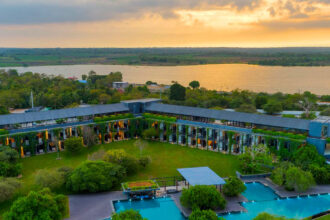The Sri Lankan elephants are one of three recognised subspecies of the Asian elephant and is native to Sri Lanka. In general, Asian elephants are smaller than African elephants and have the highest body point on the head. The tip of their trunk has one finger-like process. Their back is convex or level. Females are usually smaller than males and have short or no tusks.
With the urbanisation of the country, the habitat of Sri Lanka elephants has been reduced to the dry zone in the north, east and southeast of Sri Lanka.
Sri Lanka elephants, do they attack?
Yes, if provoked. They are known for living in matriarchal (female-led) social groups, and although elephants are respected and revered by people, they are also feared because they can be aggressive and extremely dangerous.
When are elephants most dangerous?
Musth, pronounced ‘must’, is when males experience increases in testosterone levels. The changes prepare them for competing for females and make them much more aggressive. The condition can last for up to sixty days. Elephants in musth carry their heads and ears higher than normal and make a characteristic rumbling sound. A bull elephant in musth can be extremely dangerous to anything that gets in his way.
Where to see elephants in Sri Lanka in their natural habitat
Sri Lanka has over 26 national parks. Visiting a national park on a safari to see elephants is popular with tourists visiting Sri Lanka. Below are the places where you can spot Sri Lankan elephants in their natural habitat.
Minneriya National park
![]() 6.00 – 18.00
6.00 – 18.00 ![]() Entrance cost $18
Entrance cost $18 ![]() Polonnaruwa, Get directions
Polonnaruwa, Get directions
Minneriya national park is one of the best places in Sri Lanka to see wild elephants in large numbers. Dominated by the ancient Minneriya Wewa, the park has plenty of scrublands, forest and wetlands in its 88.9 sq km to provide shelter and watering and feeding grounds for elephants. Toque macaques, sambar deer, buffalo, crocodiles and leopards can also be seen in the park.
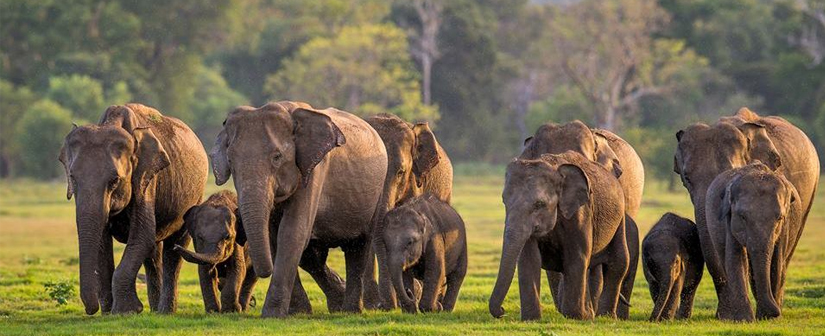
Best time visit
The dry season, from April to October, is reckoned to be the best time to visit (as by than water in the tank has dried up, exposing grasses and shoots to grazing animals). Elephants, which can number 300 or more, come to feed and bathe from all parts of Sri Lanks in September during what is known as ‘the Gathering’.
Getting there
The park entrance is on Habarana–Polonnaruwa road. A visitor centre near the entrance sells tickets and has a few exhibits about the park’s natural history. The initial 40-minute drive (along a poor dirt road) into the heart of the park is through dense forest, where wildlife sightings are rare. But then the landscape opens up dramatically, and the views across the tank are superb. The early mornings are generally best for birds and late afternoons for elephants.
Kaudulla National Park
![]() 6.00 – 18.00
6.00 – 18.00 ![]() Entrance cost $18
Entrance cost $18 ![]() Polonnaruwa, Get directions
Polonnaruwa, Get directions
Declared a national park in 2002, Kaudulla National Park is dry evergreen forest. Its 66.56 sq km is connected with a jungle corridor to the nearby Minneriya Wildlife National Park.As well as elephants, Kaudulla National Park is home to 23 species of mammals that include the Sambar Deer, Sri Lankan Axis Deer, Chevrotain, Wild boar. Leopard and sloth bear sightings are rare.
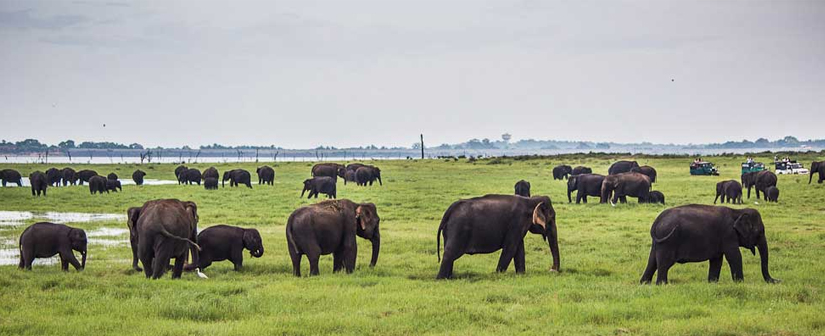
Best time visit
The best time to visit Kaudulla National Park is between August and December. The great elephant gathering around the water reservoir takes place in the dry season of September to October. However, this is a year-round destination. Safaris in Kaudulla can be done in the morning or afternoon. The afternoon safaris are less busy but best for sighting elephants.
Getting there
Located 190 km away from Colombo in Polonnaruwa, Kaudulla can be reached by Colombo- Trincomalee main road. The entrance to Kaudulla National Park is 22 km north of the village of Habarana.
Kalawewa National Park “The Land of the Tusker Elephant”
![]() 6.00 – 18.00
6.00 – 18.00 ![]() Entrance cost $18
Entrance cost $18 ![]() Anuradhapura, Get directions
Anuradhapura, Get directions
Declared a National Park in 2015 the 60 sq km Kalawewa National Park houses two water tanks, Kalãwewa and Balaluwewa, built by the Sri Lankan King, Dhatusena. in the 5th century BC. There’s also a 45 feet high standing Avukana Buddha statue built during the same era.
However, the limelight is claimed by the tusker elephants thus the park is known as “The Land of the Tusker Elephant”
In Sri Lanka’s elephant population about seven per cent are tuskers. Kalawewa Oya wildlife national park boasts housing most number of the tuskers. This is a good alternative to witness an elephant gathering or getting away from the busy crowds in other parks.
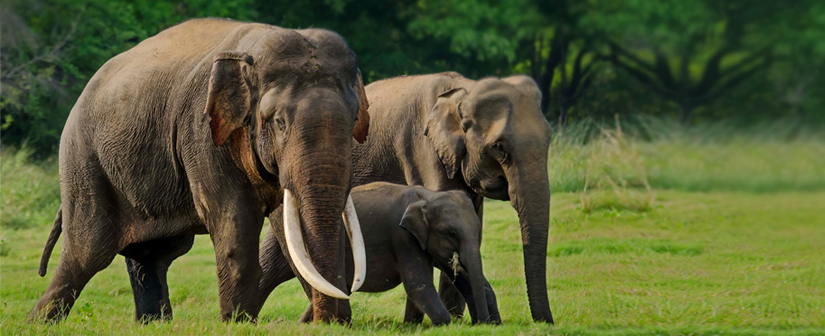
Best time visit
Best time to visit Kalawewa National Park is from March to July. Safaries could be done either in the mornings or early evenings when elephants gather to drink water and feed.
The monsoons arrive around October – November and the grasslands fill up as reservoirs. While the resident elephant herds remain, the migratory elephants return from whence they came. The Park’s beautiful Kumbuk trees and vegetation complement the reservoirs, birdlife and pristine surroundings.
Getting there
A four-hour drive on the Ambepussa – Kurunegala, Kurunegala- Dambulla, turn at Madatugama is Kalawewa National Park.
Wasgamuwa National Park
![]() 6.00 – 18.00
6.00 – 18.00 ![]() Entrance cost $18
Entrance cost $18 ![]() Hettipola, Get directions
Hettipola, Get directions
The tropically dry mixed evergreen forest, located in Polonnaruwa 225 km away from Colombo, is Wasgamuwa national park. It is 369 sq km in area, bordered by River Mahaweli Ganga and River Amban Ganga in east and west.
Wasgamuwa is one of the protected areas where Sri Lankan elephants can be seen in large herds. It is also one of the important bird areas in Sri Lanka
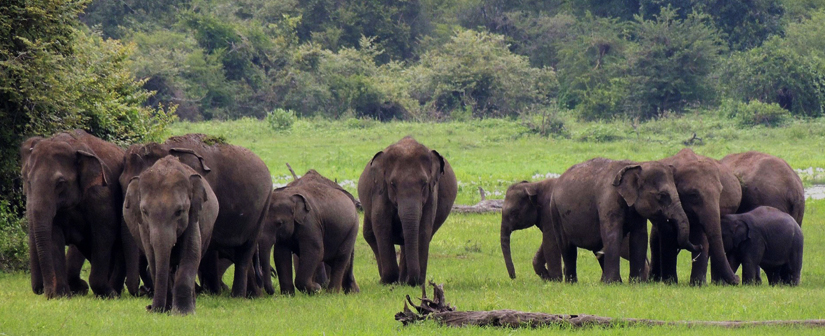
Best time visit
The best time to enjoy the sight of large herds is from November to May. In the rest of the year, the elephants tend to migrate to nearby Minneriya and Kaudulla National Parks.
Getting there
The entrance to Wasgamuwa National Park is at Handungamuwa
Udawalawe National Park
![]() 6.00 – 18.30
6.00 – 18.30 ![]() Entrance cost $18
Entrance cost $18 ![]() Udawalawe, Get directions
Udawalawe, Get directions
Framed by soaring highlands on its northern boundary, Udawalawe National Park is 308.21 sq km in area, the sixth largest animal sanctuary of Sri Lanka. It is located 180 km from Colombo in the south-central sector of the island.
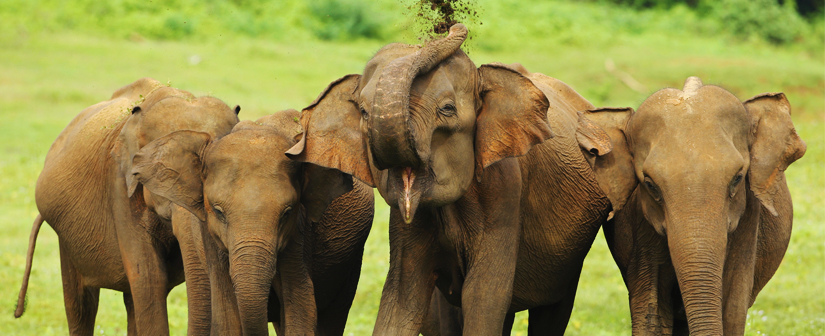
Best time visit
Udawalawe is undoubtedly the best place in Sri Lanka to see wild Asian Elephants throughout the year: there are about 500 elephants in the park and they often roam in herds of up to 100. Udawalawe National Park is unique in terms of consistency in numbers of elephants roaming the park: it has no seasonal variation in herds of elephants. The best hours to visit the park are in the mornings and evenings. Late evenings also affords photographic opportunities against the backdrop of stunning sunsets.
Getting there
The entrance to Udawalawe National Park is located near 11km post between Timbolketiya and Tanamanwila on Pelmadulla-Timbolketiya A18 road
Sri Lanka Holiday Guru Tip
We recommend taking an experienced tracker with you. Your wilderness experience is only as good as your guide.
Do not attempt to feed the elephants and avoid carrying any sort of food with you.
As much as you need that photo or video, getting close to the elephants is inviting trouble as they really are wild, and thus unpredictable and dangerous animals
Subscribe to our newsletter to get our newest articles instantly!




